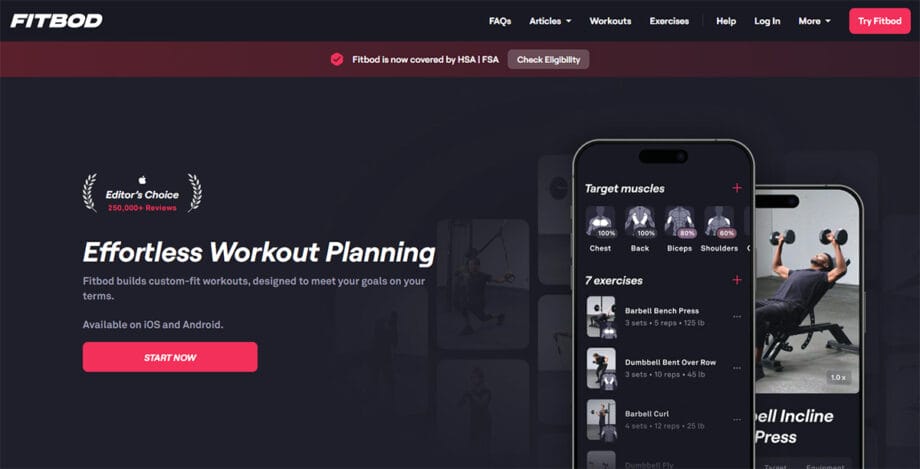The fitness industry has undergone a remarkable transformation with the advent of technology, particularly mobile applications.
Among these innovations, AI-powered fitness apps like Fitbod have carved a significant niche by providing customized workout plans, real-time adjustments, and data-driven insights. Such apps enhance user engagement and improve results by adapting to individual progress and needs.
If you’re aiming to develop a similar AI fitness app, understanding the investment involved is essential. This article dives deep into the overall cost, market dynamics, key features, and developmental steps to guide you through building a successful AI-powered fitness app like Fitbod.
Fitbod: A Comprehensive Overview
Fitbod is a fitness app that uses machine learning to generate personalized workout routines based on user preferences, available equipment, and workout history.
Its AI engine adapts daily plans to optimize muscle recovery and progression, ensuring users get the best workout possible. What sets Fitbod apart is its deep integration of data analysis and AI algorithms that tailor every session to the user’s unique circumstances.
The app supports both beginners and advanced athletes by dynamically adjusting difficulty and exercise selection. Its success is attributed to this personalized approach, seamless user experience, and extensive exercise library complete with instructional videos and rep guidelines. Beyond just tracking workouts, Fitbod offers a smart fitness companion that evolves with the user.
Market Size of AI and Fitness Apps
The global fitness app market has witnessed exponential growth, especially post-pandemic, as more people embrace digital fitness solutions.
Valued at several billion dollars, this market is expected to continue expanding at double-digit growth rates yearly. The rising demand for personalized health and fitness advice, coupled with advancements in AI technology, bolsters this trend.
Artificial intelligence’s role within this space is growing rapidly, offering capabilities such as real-time feedback, injury prediction, and behavioral coaching.
As wearable devices collect vast amounts of health data, apps can analyze and transform this data into actionable workout plans. According to industry research, AI-enabled fitness apps are projected to capture a significant market share due to their superior personalization and efficiency.
Core Features of a Fitness App like Fitbod
To develop a competitive AI-powered fitness app, there are core features to consider:
- Personalized Workout Generator: This is the heart of the app, where AI algorithms design adaptable workout routines based on user inputs and past performance.
- User Profile and Progress Tracking: Collecting detailed user metrics such as weight, fitness goals, and workout history to tailor future sessions.
- Exercise Library: A vast repository of exercises with video demonstrations, target muscles, and difficulty levels.
- Wearable Device Integration: Syncing data from devices like Apple Watch or Fitbit for real-time monitoring and accuracy.
- Recovery and Fatigue Monitoring: Using AI to predict muscle recovery status and avoid overtraining.
- Social Sharing and Community: Features that encourage user engagement through sharing progress and participating in challenges.
- Push Notifications and Reminders: To motivate users to stick with their fitness routine.
- Multi-Platform Accessibility: Availability on iOS, Android app stores, and possibly web-based dashboards.
Including these features influences the overall usability, retention, and ultimately the cost of app development.
Cost of Building an AI-Powered Fitness App Like Fitbod
The development cost varies widely based on how many and which features you include, the complexity of AI integration, and the choice of development team. Building a basic AI workout app with moderate features might start around $100,000, while a full-fledged, multi-featured app like Fitbod with advanced AI models could exceed $300,000.
The AI engine development itself requires investment in data collection, model training, validation, and continuous improvement, often involving data scientists and AI specialists who command premium rates. Besides coding, high-quality content creation for exercise videos and UX/UI design also adds to the cost.
Post-launch expenses must be accounted for as well, including hosting, user support, ongoing AI enhancements, bug fixes, and updates in compliance with health data regulations.

Key Factors Influencing the Development Cost
Several factors determine the total price of your AI fitness app project:
- Artificial Intelligence Complexity: Simple rule-based algorithms cost less than self-learning, adaptive models.
- Content Quality and Volume: Professional exercise videos, graphics, and instructional content increase the time and resources needed.
- Number of Platforms Supported: Developing for both Android and iOS raises costs compared to a single platform.
- Data and Device Integration: Syncing with wearable devices and third-party APIs requires additional development.
- Team Expertise and Location: Hiring seasoned developers and AI experts from high-cost regions drives the price higher.
- Design Requirements: Highly customized UI/UX with smooth animations demand more development time.
- Security and Compliance: Safeguarding user health data involves encryption, audits, and legal consultations.
- Post-Launch Maintenance and Updates: Budgeting for continuous improvement is essential.
Each of these factors can shift the cost envelope significantly, so clear prioritization and planning are vital.
Emerging Trends Shaping AI Fitness Apps
While Fitbod and similar platforms have set the standard, AI-driven fitness technology is evolving rapidly. To stay competitive, developers should incorporate these emerging trends:
- Voice-Enabled Coaching: Integration with digital assistants like Siri, Alexa, and Google Assistant is making fitness more conversational, allowing users to start workouts or receive feedback hands-free.
- Gamification: Reward systems, levels, and challenges are being used to improve adherence by making fitness fun and competitive.
- AR/VR Integration: Augmented and virtual reality are creating immersive training sessions where users can virtually “attend” fitness classes or interact with AI coaches in a simulated gym.
- Hyper-Personalization with GenAI: Generative AI creates personalized meal plans, motivational messages, and adaptive training programs tailored to each user’s mood and progress.
- Predictive Injury Prevention: With biomechanical analysis and AI-driven modeling, apps can warn users about fatigue risks, poor form, or muscle strain potential.
Keeping an eye on these trends ensures your app doesn’t just keep up but leads the fitness revolution.
Monetization Models for AI-Powered Fitness Apps
Creating a world-class fitness solution is only half the journey; ensuring profitability is equally important. Here are the leading revenue models used by apps like Fitbod:
- Subscription Plans: Monthly or yearly subscriptions remain the primary model, typically offering a free trial followed by tiered pricing.
- Freemium + Premium Features: Offer basic workouts for free, but paywall custom AI plans, advanced analytics, or specialty programs.
- In-App Purchases: Users pay for add-ons like meal plans, exclusive training modules, or premium exercise libraries.
- Partnerships with Gyms & Trainers: Apps can integrate with gyms, offering hybrid digital + physical memberships.
- Corporate Wellness Programs: Partnering with companies to offer fitness subscriptions as employee benefits.
- Advertising & Sponsorships: Carefully integrated ads for sports gear or nutrition brands can become an additional stream.
Choosing the right mix of these models depends on your target audience and business goals, but subscription-driven revenue with optional add-ons is currently the most successful.
Steps to Develop an AI-Powered Fitness App
Launching a successful AI fitness app like Fitbod involves a carefully structured development process:
- Market Research and Validation: Understand target users, competitor landscape, and unique value proposition.
- Define Product Requirements: Detail the features, AI capabilities, and technical specifications.
- Design User Experience: Craft wireframes and prototypes focusing on user engagement and ease of use.
- Select Technology Stack: Choose programming languages, cloud services, AI frameworks, and databases.
- Assemble Development Team: Engage developers, AI experts, UI/UX designers, and QA engineers.
- Build Core Functionality: Develop workout generation engine, user profiles, and integration modules.
- Content Creation: Produce or license exercise videos, tutorials, and instructional materials.
- Testing and Quality Assurance: Conduct multiple testing phases, including AI model performance and security validation.
- Deployment: Launch on app stores and monitor initial user feedback.
- Continuous Improvement: Optimize AI models, add features, and maintain compliance.
This process ensures a steady focus on quality, user-friendly design, and scalable AI capabilities.
Final Thoughts

Building an AI-powered fitness app like Fitbod is not a trivial endeavor but a rewarding investment if done correctly. The cost reflects the complexity, quality, and ambition of your project. Partnering with a reliable AI app development company that understands fitness technology can guide you through development milestones efficiently and help manage costs without compromising on quality.
Whether you are starting with a minimum viable product or aiming for a fully featured launch, clear planning and phased execution will maximize your chances of success. If this article helped you navigate the complexities of AI fitness app development, please share it or link it on your platform. Sharing knowledge empowers innovators to create better, smarter fitness tools.







